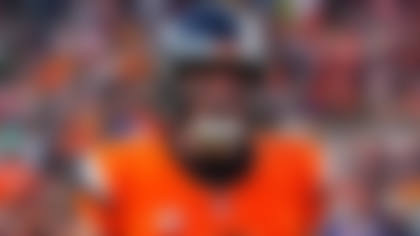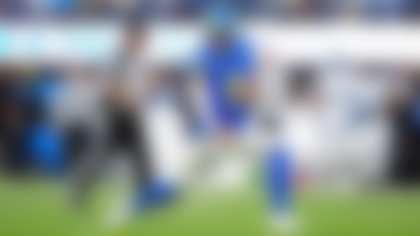BOURBONNAIS , Ill. - Five observations from the Bears training camp:
1. Concerns up front
The offensive line could be a bigger worry than the quarterback.
First-round draft choice Chris Williams was expected to move into the starting lineup at left tackle, but he required back surgery early in training camp and is not likely to be available before mid-season, at the earliest. His season could be a total washout, although the Bears plan to keep him on the active roster for now.
Even with Williams gone, the Bears have gone ahead with their plan to move John Tait, last year's starting left tackle, to the right side. That meant they had to plug swingman backup John St. Clair into the lineup at left tackle. St. Clair was a right tackle earlier in his career when he started for the Rams and Dolphins, and was barely adequate at that spot.
Moving St. Clair to left tackle is a risky move, something even the Bears obliquely acknowledge. General manager Jerry Angelo called the offensive line an unknown which still is developing, saying, "We've got to galvanize that position."
Further, left guard Terrence Metcalf has been missing work due to a knee injury. As a result, the Bears may open the season with an offensive line that has not had much practice time together.
2. Safety issue
The health of free safety Mike Brown is vitally important to the Bears' success.
"Mike Brown is the heartbeat of the defense," defensive tackle Tommie Harris said.
But the heartbeat missed 43 of 64 games the last four years because of a series of lower-body injuries, including suffering a season-ending knee injury in Week 1 of 2007 against San Diego.
That, of course, was just one on a long list of injuries that plagued Chicago last season, but led to a domino effect that resulted in the Bears using six different starting lineups in the secondary over the first seven games of the season. Cornerback Nathan Vasher also missed most of the season, and no defensive back started every game.
Brown is the smartest player on the defense and has terrific instincts that have allowed him to become the franchise's all-time leader in defensive touchdowns. The Bears have moved Brown from strong safety to free safety to try to reduce the wear on his body. They need him healthy, and they may not have sufficient depth at the position if he is hurt again.
3. Men in the middle
Defensive tackle Tommie Harris, who played almost all of last season with an aching knee, appears to be healthy, and that is very significant.
Defensive tackle is the other prime area of concern on the defense. The run of injuries a year ago resulted in the Bears playing a defensive tackle picked off the Cincinnati practice squad (the Bengals were 27th in the NFL on defense) and two others they acquired as late-season, off-the-street free agents.
Problems began in the first game when Dusty Dvoracek, the other starting defensive tackle, sustained a torn ACL. Harris was ailing from the third game, when he was leg-whipped in the knee. Dvoracek's replacement, Darwin Walker, missed five games with injuries, and another replacement, Anthony Adams, missed four.
Adams, a free agent find let go by San Francisco, is healthy now and appears to have solidified a starting job next to Harris. Adams is undersized (six-feet, 307 pounds) by normal NFL standards, but his non-stop effort makes up for a lack of stature. Nonetheless, the key to this area is Harris, whose late-season injury in 2006 is considered by some Bears' people to be one of the reasons they lost the Super Bowl to Indianapolis two years ago (in that game, the Bears were gashed for 191 yards rushing, nearly twice their average for 18 previous games).
Dvoracek is a major question mark due to health. He missed his entire rookie season in 2006 due to a foot injury, then had the knee injury last year and this year already missed much off-season work due to a wrist problem and the early part of training camp due to a pulled calf muscle. Walker is no longer with the team.
4. New offensive threat
Devin Hester has a chance to make an impact as a wide receiver.
In two years, Hester already has established himself as one of the best return specialists in NFL history; just on special teams he scored more touchdown in 2006-07 than any other Chicago player. Now the Bears, desperate for playmakers, hope to get the ball in his hands more as a wide receiver.
The plan is to use Hester about 30 to 35 plays a game on offense, according to offensive coordinator Ron Turner. The Bears want opponents to get used to seeing Hester on the field so that they won't automatically key on him every time they see him.
Hester, formerly a defensive back, struggled with the transition when it started during the season last year. However, coaches and teammates say they have seen marked improvement now that he had an entire offseason to try to learn to play receiver. He dropped one decent bomb from Rex Grossman in a recent practice but generally appears to be doing a good job both catching the ball and running his routes.
In spot play a year ago, Hester frequently lined up in the wrong place or did not run his route precisely. Now, Grossman said, "He's made a lot of progress. He's running routes... without having to think about (it). He's got great football instincts and he does things on his own that are remarkable, that are exactly what we want him to do, but weren't exactly coached in that way. He's got a great feel for the game."
[Camp: Bourbonnais, Ill.
Preseason games:
Aug. 7:
Chiefs 24, Bears 20
Aug. 16:
at Seattle, 9:00 p.m. ET
Aug. 21: San Francisco, 8 p.m. ET
Aug. 28: at Cleveland, 7:30 p.m. ET
There remains some question about whether the move will work, and the possibility it will wear Hester down and harm his great return game. He insists it won't, pointing to a 2006 game at St. Louis when injuries forced him to play a good bit at cornerback, his previous position, and he still managed to return two kickoffs for touchdowns in the same game. Of course, one game hardly constitutes a steady diet, but Hester said he's actually getting acclimated faster than he expected.
"It's a new process, but the more you put in, the more you get out of it, the more you start understanding, the more exciting it gets," Hester said.
Coach Lovie Smith is trying not to get too excited, however.
"He's a rookie receiver," Smith said.
5. Running of the Bears
The offensive line permitting, the Bears will become a running team again.
Second-round draft choice Matt Forte appears to be winning the race to become the starting running back, and he also appears to be learning all the aspects of his job including pass protection and receiving.
Forte, who rushed for 2,127 yards last season at Tulane, looks forward to being a workhorse; unfortunately for him, given the quarterback issues on the team, he can expect to be running against a lot of eight-man fronts. Smith likes to say that the Bears "come off the bus running," but last season they got out of character, just one of the reasons for a disappointing 7-9 record.
Chicago -- which in its NFC championship season of 2006, rushed the ball 503 times (fifth in the NFL) -- ran it just 423 times in 2007, putting it in the bottom half of the league. And the average yards per carry dropped from 3.8 to 3.1, a significant falloff.
"We didn't run the ball as much as we wanted to, and we didn't run the ball as effectively as we wanted to," Turner said.
Forte brings a nice blend of speed, quickness and power to the Bears but prides himself mostly on his consistency. For a team that jettisoned Thomas Jones after the 2006 season and then dumped his replacement, Cedric Benson, after offseason legal troubles, that would be a good change.
Veteran NFL writer Ira Miller is a regular contributor to NFL.com.



